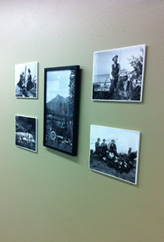 I bet you didn’t know that the Archives & Special Collections has several boxes of what are known as “glass plate negatives.” These are literally photo negatives on pieces of glass, and they are extremely delicate (being thin glass). Most of the small black and white photos along the wall of librarians’ offices in the Information Commons are actually prints of these negatives, so if you’d like a good example, that’s the place to look.
I bet you didn’t know that the Archives & Special Collections has several boxes of what are known as “glass plate negatives.” These are literally photo negatives on pieces of glass, and they are extremely delicate (being thin glass). Most of the small black and white photos along the wall of librarians’ offices in the Information Commons are actually prints of these negatives, so if you’d like a good example, that’s the place to look.
Instead of being the stark black and white negatives on plastic that we’re more prone to think of now, this 19th-20th century technique created plates with less definitive contrast, resulting in dark grey-versus-light gray areas. However a glass negative was still preferable to paper, as paper resulted in “unsatisfactory” results due to paper grain and fuzziness. A glass plate negative was typically done using a “wet” method, where the glass would be coated in a photo-sensitive substance and immediately sensitized, exposed and developed before it could dry, which took anywhere from five to fifteen minutes. Most of the negatives we have boxed up are more than likely “dry plates, “ though, since the University was established in 1888, and “wet plates” quickly went out of style in 1880, after the dry plate came into existence.
Another “problem” with glass plate photography was size – enlargement was impractical in the 1800s, so any created negative would need to be in the desired size of the final print. Can you imagine trying to carry around a 20×24 inch piece of glass or two without breaking it? No wonder photography was a big deal back then.
This glass-plate method was used up until about 1975, when the cellulose negative finally became popular. After that, of course, we moved onto digital photography, which doesn’t require a negative at all.
By Morgan Ford
